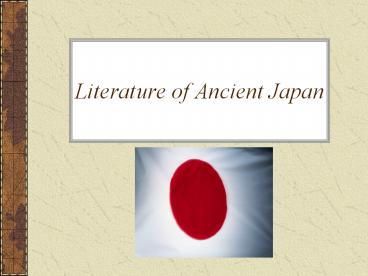Literature%20of%20Ancient%20Japan - PowerPoint PPT Presentation
Title:
Literature%20of%20Ancient%20Japan
Description:
Literature of Ancient Japan Historical Highlights (488-9) Heian Period 794-1185 High Point of imperial rule Highly cultured court develops. Those of the court painted ... – PowerPoint PPT presentation
Number of Views:352
Avg rating:3.0/5.0
Title: Literature%20of%20Ancient%20Japan
1
Literature of Ancient Japan
2
Historical Highlights (488-9)
- Heian Period 794-1185
- High Point of imperial rule
- Highly cultured court develops. Those of the
court painted, wrote poetry, and participated in
elaborate ritual - Feudal system
3
H.H. (cont.)
- Kamakura Period
- Daimyo
- Military governors
- Oversaw the samurai
- Oversaw specific regions
4
H.H. (cont.)
- Warring states period
- Civil war all over Japan
- Tremendous power struggle
- Pay offs very political
5
H.H. (cont.)
- Tokugawa Period
- Edo
- Japans capital
- Edo becomes Tokyo
- closed country policy established until 1854
- Reaction to rapid spread of Christianity
- Christians are persecuted
6
People and Society (490-91)
- Rulers
- Emperor
- Highest position in Japanese society
- Never seen by common people
- Symbolic
- Held no political power
- Shogun
- Military dictators
- Real power
- Ruled in emperors name
- Daimyo
- Answered to the shogun
- Every other year in the capital
7
P and S (cont.)
- Samurai
- Elite class of warriors loyal to daimyo
- Followed Bushido (way of the warrior) expected
to show courage, reverence for gods - Many also practiced Zen Buddhism (form of
self-discipline and living in harmony w/ nature) - Only group allowed to carry swords
- Strict code of honor
8
P and S (cont.)
- Peasants
- Made up about 80 of population
- Not allowed to carry swords or use their family
names - paid hefty taxes (half of harvest)
- Were told what to produce, when to work, what to
eat, etc. - Some had to sell family members
- Eventually rebelled
9
P and S (cont.)
- Artisans and merchants
- - roofers, masons, carpenters, swordsmiths
- Some swordsmiths became close with samurai
- Merchants not respected because they did not
produce anything. However, many lived in
prosperity. - Became more well-respected over time
10
P and S (cont.)
- Women in Early Japan
- If men died in warfare, some women went to war
themselves - The supreme duty of a woman was to honor the men
in her life - Typical Japanese women were peasants who took
care of the home.
11
Arts and Culture (492-93)
- Theater
- Noh
- Oldest form
- Masks, formal language, mime, gestures
- Kabuki
- Colorful costumes
- History/contemporary urban life
- Bunraku
- Puppet theater
12
A and C (cont.)
- Painting usually representative of nature
- Beauty and tradition
- Black ink
- Woodblock prints
13
A and C (cont.)
- Literature
- Excelled in poetry
- Tanka
- 31-syllable lyrical poems that deal with nature
and love - Haiku
- 17-syllable poem that presents images of nature
14
A and C (cont.)
- Religion and Architecture
- Shinto
- way of the gods
- Reverence for nature
- No complex rituals
- Buddhism
- More complicated
- Eliminate attachment to material things to
achieve peace - Zen
- Spiritual enlightenment through both
self-discipline and meditation
15
A and C (Cont.)
- Architecture
- Religious building
- Inspired modern buildings as well
- Japanese always try for harmony with nature
16
Connect to Today (496-97)
- Food
- Art
- Zen
- Fashion
- Nature
17
Time honored tradition
18
Mt. Fuji tallest mountain/volcano in
Japan
19
Hiroshima only structure left
standing after the bomb
20
- Guns/Hunting illegal in Japan
- Monkeys and deer are not afraid of human
interaction
21
(No Transcript)
22
(No Transcript)
23
(No Transcript)
24
(No Transcript)
25
Golf in Japan
- One cart per foursome. It stays on the path on a
type of track (like a train). - One member of the foursome has a button remote
that starts and stops the cart. - The locker rooms are like country club style
with an Onsen bathing pool.
26
Golf Continued
- Cost for golf in Japan is a range roughly between
100-300 - 24 hour driving ranges are popular and more
practical for people who want to learn golf. - They have double and triple deck driving ranges
in the cities. - We would sometimes work until 11pm, grab a
sandwich at the 7-11 and head over to the driving
range. pretty cool.
27
(No Transcript)
28
(No Transcript)
29
(No Transcript)
30
(No Transcript)
31
(No Transcript)
32
Here endeth the lesson
- Andrew C. Jackson, 2007
- Patrick W. Danz 2014































